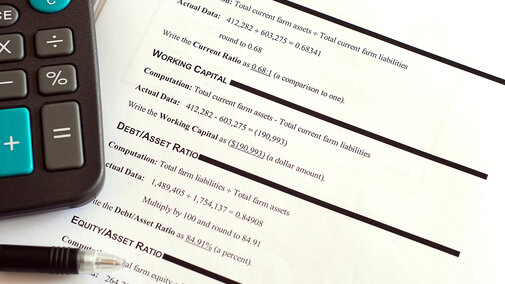Over time, negative cash flows will put farm and ranch businesses, and the lifestyle of the owners, at serious risk. The following suggestions for adding to cash flow are adapted from Iowa State Extension AgDecsionmaker C3-58, Farm Financial Management: 16 Ways to Stretch Cash Flow, written by William Edwards, retired extension ag economist.

- Cancel or re-negotiate leases that are unprofitable. Not all cropland is worth the same as other land. Rental rates should fit the productivity of the land. Flexible cash rents or a crop-share lease can be proposed in place of fixed cash rent.
- Use financial reserves. These may include savings or liquid financial assets such as stocks or bonds. However, consider the taxes that may accompany selling investments. Review current market prices and your basis to determine capital gains tax owed.
- Sell current assets such as stored crops and market livestock; however, don’t sell off market livestock that's not yet finished as the sales discount may be too steep.
- Use credit reserves or unused borrowing capacity. Analyze the decision to use more debt first and have a realistic plan to repay that borrowing.
- Refinance debt by using equity. Lengthen repayment terms or refinance loans with balloon payments that would require a large payment at the end of the borrowing period, when cash flow may be improved. Here again, look at the ability, if needed, to refinance the balloon payment.
- Defer capital asset purchases. Sometimes making a purchase or leasing equipment could reduce costs by lowering repairs that use more cash than the lease or purchase payment. Analyze carefully which strategy best reduces cash flow.
- Utilize FSA Guaranteed loans.
- Utilize FSA low-interest marketing loans. Placing grain under loan can be used to pay off high-interest rate loans.
- Increase non-farm earnings. Even if one member of the farm family is already working off the farm, all may need to at least for a time.
- Decrease non-farm and family living expenditures. Set and use a family living budget. The budget needs to prioritize expenditures to those necessary such as utilities, food, and health insurance. Defer expenditures such as for vehicles, vacations, recreation and discretionary expenses.
- Sell assets that aren’t earning their keep. Farmland that is consistently unprofitable, machinery that costs more than custom work or assets that no longer have a use on the farm or ranch meet this definition. Consider selling them to raise cash. Funds gained from the sale can be used in more productive manner such as paying down existing debt, or investing into an asset that will provide returns. Capital gains tax will be owed on any business property that is sold for more than its reported basis. For assets sold that were held longer than one year, that capital gains tax rate could be 0%, 15%, or 20%, depending on your taxable income and filing status.
- Consider joint machinery ownership. This can work, but communication and periodic compromise may be necessary for success. Spending time in the beginning creating a written agreement can avoid unnecessary fallouts later on. Periodic reviews of the agreement can insure that it remains relevant.
- Seek outside investors or lenders or possibly seek a loan or the free use of equipment from family. Think through lending to or borrowing from family. It can be a difficult situation for all involved.

